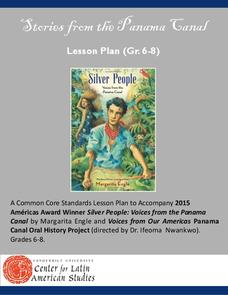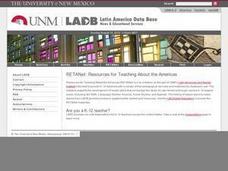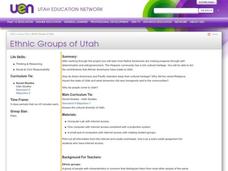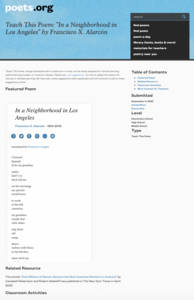Constitutional Rights Foundation
History of Immigration Through the 1850s
Everyone living in the United States today is a descendant from an immigrant—even Native Americans. Learn about the tumultuous history of American immigration with a reading passage that discusses the ancient migration over the Bering...
Curated OER
Why Kosovo? Why Now?
Students explain the establishment of the modern state of Yugoslavia and the breakup of the country. They examine the human characteristics of the region - ethnic groups, languages, and religions.
Curated OER
American Indians, European Settlers, and Colonial Arkansas
Young scholars identify the interdependence among various ethnic groups in early Arkansas history. They illustrate timelines and visit historic sites. They make maps of the site and give class presentations.
Curated OER
Defining Ethnic Minorities in China
Ninth graders, in groups, research some of China's 56 identified ethnic groups. They prepare maps and posters to display their research.
Curated OER
By Any Other Name
Students examine the differences between the definitions of race and ethnicity defined by the United States government. After reading an article, they discuss the possiblity of the elimination of some races from the 2010 census. They...
Curated OER
The Other Americans
Students explain the concept of culture and identify the components of a culture. They describe the characteristics of selected immigrant groups and the conditions they faced upon arrival in the United States. Students analyze the...
Vanderbilt University
Stories from the Panama Canal
The stories of the Silver People, the West Indies immigrants hired to work on the Panama Canal, come to life in a lesson about the building of the Panama Canal. Groups research why the canal was built, how it was build, the working...
Missouri Department of Elementary
A Stranger Among Us
The final lesson in the R.E.S.PE.C.T series asks eighth graders to expand their vision beyond the walls of the classroom and to consider how they can promote acceptance and respect of others within in the global community. "A Stranger...
Curated OER
Food Choices: A Socio-Cultural Decision
Students discuss their food preferences. Using a flannel board and food models students describe what they would like to eat for dinner. Students compare their selections with their classmates. Students identify the nationality of ethnic...
Curated OER
Different Ethnic Groups in Ecuador, Panama and Argentina: Their Assimilation and their Contributions
Students research various Latin American countries and reflect on the different ethnic communities represented in that country and their contributions to the region. They make posters, perform skits and write letters about their research.
Curated OER
Ethnic Groups of Utah
Students investigate how ethnic minorities have impacted the State of Utah.
Curated OER
Exploring Racial and Ethnic Diversity
Pupils explore and examine racial and ethinic diversity in the metropolitan areas of the United States. They examine data from the US Census Description of Race and Ethnic Categories. Students explore the population by race and ethnicity...
Curated OER
United States Pride
Third graders learn the responsibility of citizenship and learn facts about a state they choose to research.
Museum of Tolerance
Just What Kind of American Are You?
Your parents were both in different countries. You were born in the US. Documents and application forms ask you to identify your racial or ethnic classification. Which box do you check? Class members collect documents and application...
Teaching Tolerance
Why Do We (Still) Celebrate Columbus Day?
What are we really celebrating on Columbus Day? The resource explores the narrative behind Columbus Day and ways for people to change the perception. Scholars also review vocabulary terms associated with the topic and how attitudes have...
Maryland Department of Education
The Concept of Diversity in World Literature Lesson 1: Unit Introduction
To launch a unit study of the concept of diversity in World Literature, class members compare Chinua Achebe's essay, "An Image of Africa: Racism in Conrad's Heart of Darkness" and Richard Rodriguez's essay, "The Chinese in All of Us: A...
Teaching Tolerance
Understanding the Prison Label
Break the chain. An engaging lesson examines why it is so hard to break free of the prison system in the US. Academics participate in a reader's theater, read primary sources, and discuss their thoughts. The lesson explains the hardships...
Center for History Education
Helping to Move On? An Analysis of the Reconstruction Amendments
Reconstruction amendments: a helping hand or another form of slavery? An inquisitive instructional activity compares the Reconstruction legislation that ended slavery, granted citizenship, and protected voting right for African American...
Academy of American Poets
Teach This Poem: "In a Neighborhood in Los Angeles" by Francisco X. Alarcón
After sketching an essential person and reading an article, scholars read the poem "In a Neighborhood in Los Angeles" by Francisco X. Alarcón. They listen to the poem in English and Spanish and record lines that stand out to them. Small...
Anti-Defamation League
Bellen Woodard, Identity, and “Crayon Activism”
Scholars learn about a young child turn activist and author, Bellen Woodard. Learners discuss identity, the importance of representation, and how activism makes a difference. Small groups brainstorm ways to create change and the steps to...
Curated OER
Turkey: Traditions And Today
Students research and analyze nation building, identifying countries established for various reasons. They study the history of the land now called Turkey and Ataturk, Father of the Turks. They identify the different ethnic groups that...
Curated OER
The News Spreads
Students examine ethnicity and the Gold Rush. In this lesson on the Gold Rush, students research the different ethnic groups present at the Gold Rush. Students will work in groups to answer questions concerning ethnicity and fill out an...
Curated OER
Blood Brothers
Students study the blood characteristics of a number of distinct racial/ethnic groups. They build skills in observation, information gathering and processing. Students experiences strongly reflect the nature and intent of the current...
Curated OER
Who Are These Chinese People?
Students research the Han, a main Chinese ethnic group and the Hui, another numerous group. They write a paper about the Hui including geography, religion, eating habits, languages, politics and customs.
Other popular searches
- Caribbean Ethnic Groups
- Chinese Ethnic Groups
- African Ethnic Groups
- Ethnic Groups Central Africa
- Ethnic Groups of Texas
- Perception of Ethnic Groups
- Ethnic Groups in China
- Ethnic Groups Middle East
- Bolivia Ethnic Groups
- Ethnic Groups Wwii
- China's Ethnic Groups
- Nigerian Ethnic Groups

























